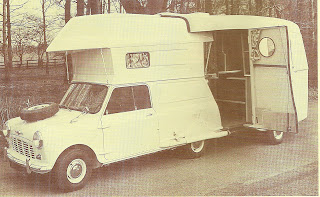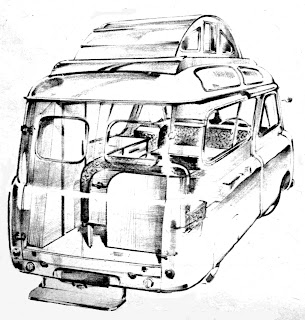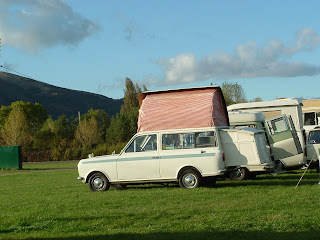Austin-Morris 'Mini' campers
In my 40+ year involvement with UK motorhomes and campervans, I have come across some weird, and strange examples, so in this blog I'm deviating from my own ongoing campervan story to bring you just a small sample, taken from my huge archive of motorhome material. I'm going to focus upon the British Mini, the iconic small car, which believe or not, did have several camper conversions based on it, though some more successful than others.
I did include a chapter about this type of campervan in my 2007 book, Classic Camper-vans; the inside story (Crowood Press), and I've included many examples over the years within magazine articles. I will kick things off with one of my personal all-time favourite 'strange' models, the 'Caraboot', a 1960s car-cum-caravan, cum-boat and camper! It was based on the Austin-Morris Mini van and was simply trying too hard to be too many things, and as a result, few were ever sold, though I believe that there is a sole survivor based in Wales. The idea behind the Caraboot (pictured below) was that the Mini van could be used separately, and then at weekends/holiday/vacation time you could mount the boat on the roof and fix the sliding rear caravan section onto the rails located on the Mini van. It was not the only camper-van conversion based on the (now) classic British Mini, as there were several, though due to its limited size, none of the conversions was a huge sales success.
Pictured below is the 'Caravilla', another white elephant conversion on the Mini, with the most hideous roof-mounted extension, which even saw the rear of the Mini being given the extension treatment! I would have hated to be driving one of these in high winds, and can't believe that it was properly thought through; I have never seen one 'in the flesh', and would be amazed if any examples survive (unless you know different?).
Pictured above is the most successful campervan conversion carried out on the Mini during the 60's, the 'Wildgoose'; available in two versions, the 'Popular' with its front-hinged rising roof, and the 'Brent', which featured a vertically extending body (VEB), with a section rising from the body to create standing room in the living section. The Wildgoose campers first appeared in 1963, built by a company in Sussex, England, either on a brand new Mini, or a customer's used vehicle; I believe that around 70 were produced in total. As far as investment is concerned, the surviving examples when offered for sale now command very high prices indeed, only two years ago a Wildgoose sold at auction in the UK for around £9000, and that was a 'basket case', requiring complete restoration. Not the most usable of classic campervans from the period, but if you are a Mini enthusiast, I suppose it is more about owning such a rare vehicle than actually camping in it.
The example below is the 'Murray Pick-a-back', and I think that this was more of a concept than a model which actually went into production; I have certainly never seen any sales literature for one, or any pictures of it appearing at motor shows. The picture speaks for itself, a demountable unit which was attached to the rear of a Mini pickup, though I think the rear over-hang left a lot to be desired.
My final 'Mini' offering is the 'Jiffy' campervan (seen below); a kit vehicle which was supplied as a pickup or campervan, both based on the Mini running gear.
The only other Mini-based camper I have heard about was a one-off Mini-Winnebago, based on the Mini Clubman estate, but I have never seen any pictures of it I'm afraid.
I did include a chapter about this type of campervan in my 2007 book, Classic Camper-vans; the inside story (Crowood Press), and I've included many examples over the years within magazine articles. I will kick things off with one of my personal all-time favourite 'strange' models, the 'Caraboot', a 1960s car-cum-caravan, cum-boat and camper! It was based on the Austin-Morris Mini van and was simply trying too hard to be too many things, and as a result, few were ever sold, though I believe that there is a sole survivor based in Wales. The idea behind the Caraboot (pictured below) was that the Mini van could be used separately, and then at weekends/holiday/vacation time you could mount the boat on the roof and fix the sliding rear caravan section onto the rails located on the Mini van. It was not the only camper-van conversion based on the (now) classic British Mini, as there were several, though due to its limited size, none of the conversions was a huge sales success.
Pictured below is the 'Caravilla', another white elephant conversion on the Mini, with the most hideous roof-mounted extension, which even saw the rear of the Mini being given the extension treatment! I would have hated to be driving one of these in high winds, and can't believe that it was properly thought through; I have never seen one 'in the flesh', and would be amazed if any examples survive (unless you know different?).
Pictured above is the most successful campervan conversion carried out on the Mini during the 60's, the 'Wildgoose'; available in two versions, the 'Popular' with its front-hinged rising roof, and the 'Brent', which featured a vertically extending body (VEB), with a section rising from the body to create standing room in the living section. The Wildgoose campers first appeared in 1963, built by a company in Sussex, England, either on a brand new Mini, or a customer's used vehicle; I believe that around 70 were produced in total. As far as investment is concerned, the surviving examples when offered for sale now command very high prices indeed, only two years ago a Wildgoose sold at auction in the UK for around £9000, and that was a 'basket case', requiring complete restoration. Not the most usable of classic campervans from the period, but if you are a Mini enthusiast, I suppose it is more about owning such a rare vehicle than actually camping in it.
The example below is the 'Murray Pick-a-back', and I think that this was more of a concept than a model which actually went into production; I have certainly never seen any sales literature for one, or any pictures of it appearing at motor shows. The picture speaks for itself, a demountable unit which was attached to the rear of a Mini pickup, though I think the rear over-hang left a lot to be desired.
My final 'Mini' offering is the 'Jiffy' campervan (seen below); a kit vehicle which was supplied as a pickup or campervan, both based on the Mini running gear.








Comments
Post a Comment